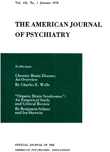THE AMYGDALAE AND BEHAVIOR
Abstract
The individual and social behavior of 15 cats and 18 rhesus monkeys was recorded and analyzed during a control period of from 3 to 15 months, during which the animals were also trained to solve increasingly complicated problems. Adaptational conflicts were used to induce persistent experimental neuroses in 3 kittens, 2 cats, 3 young monkeys and 8 adult ones. The amygdalae were then totally ablated, with some injury to the surrounding areas, in 6 of the cats and all of the monkeys; in the remaining 9 cats only the lateral or the medial amygdalae were removed.
Postoperatively, the cats exhibited: 1. no general amnesia for previous learning; 2. only mild amelioration of neurotic behavior; 3. moderate motor restlessness; 4. variable sexual drive including a phase of hypererotism; 5. markedly altered interactions with other cats and humans; 6. slowed re-learning due to low motivation and erratic or perseverative performance on both simple and complex tasks; and 7. severe disorganization of adaptive behavior after short periods of isolation and inactivity. The adult neurotic animals were: 8. markedly amenable to therapy although the kittens very low resistance to the re-induction of were only mildly so; whereas 9. all showed neuroses.
In comparison, the monkeys showed 1. an initial increase in oral activity; 2. extensive amnesia for previous learning, coupled with 3. limited diminution of neurotic symptoms in the young animals as contrasted with almost complete amelioration in the adults; 4. the ability to regain preoperative performance levels on learned problems, although the retraining period was lengthened by altered motivation, restlessness in the testing apparatus, and precipitate or inflexible responses; 5. tolerance of the proximity of or handling by a single human, contrasted with 6. fear responses to other animals or when more than one human was present; 7. increased inter-animal aggression, possibly related to 8. hypersexuality; and 9. diminished resistance to the re-induction of neuroses.
The theoretical implications of these finding were briefly considered.
Access content
To read the fulltext, please use one of the options below to sign in or purchase access.- Personal login
- Institutional Login
- Sign in via OpenAthens
- Register for access
-
Please login/register if you wish to pair your device and check access availability.
Not a subscriber?
PsychiatryOnline subscription options offer access to the DSM-5 library, books, journals, CME, and patient resources. This all-in-one virtual library provides psychiatrists and mental health professionals with key resources for diagnosis, treatment, research, and professional development.
Need more help? PsychiatryOnline Customer Service may be reached by emailing [email protected] or by calling 800-368-5777 (in the U.S.) or 703-907-7322 (outside the U.S.).



